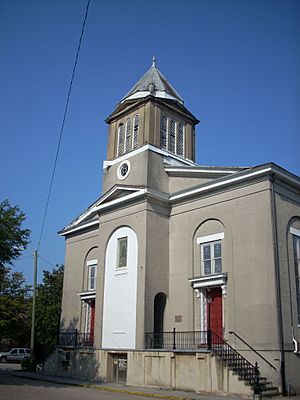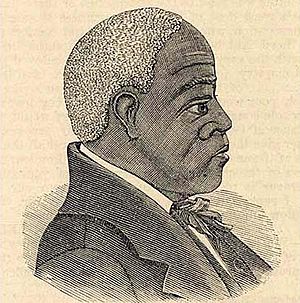First African Baptist Church (Savannah, Georgia) facts for kids
Quick facts for kids First African Baptist Church |
|
|---|---|
| First Colored Church (formerly) | |

Front view
|
|
| Location | 23 Montgomery Street Franklin Square Savannah, Georgia |
| Country | United States |
| Denomination | Baptist |
| Website | www.theoldestblackchurch.org |
| History | |
| Founded | 1777 |
| Founder(s) | George Leile |
| Architecture | |
| Years built | 1859 |
| Administration | |
| Division | National Baptist Convention, U. S. A. Inc. |
| Subdivision | General Missionary Baptist Convention of Georgia, Inc. |
The First African Baptist Church in Savannah, Georgia, is one of the oldest African American churches in North America. It started with a group of people in 1773 and officially became a church in 1788. This church has a long and important history, especially for the African American community.
Many people believe it was the very first black Baptist church. However, two other churches, the Silver Bluff Baptist Church in South Carolina and the First Baptist Church in Virginia, also claim to be the first.
Today, the First African Baptist Church has a museum. It shows many old items and stories from the 1700s until now.
Contents
The Church's Early Beginnings
The story of the church began with a man named George Leile. He was an enslaved person who became the first African American allowed to preach by Baptists in Georgia in 1773. Leile's owner, who was a Baptist, set him free before the American Revolutionary War.
Leile traveled around, sharing his faith and baptizing other enslaved people. Some of these people helped start the Silver Bluff Baptist Church in South Carolina. One important person he baptized was Andrew Bryan in 1782. Bryan later became a key leader for the Savannah church.
During the Revolutionary War, many enslaved people sought freedom by going to areas controlled by the British. George Leile and his family went to Jamaica, where he started new Baptist churches. Another leader, David George, went to Nova Scotia and later Sierra Leone, also starting churches there.
Andrew Bryan, however, stayed in Savannah. He bought his own freedom and his wife's freedom. He continued to preach and gather people for worship, even though it was difficult and he faced challenges from local authorities.
Becoming an Official Church
Andrew Bryan worked hard to make the church official. On January 20, 1788, the First African Baptist Church was formally recognized. It had 67 members at that time. They met in a barn about three miles west of Savannah.
In 1794, the church built its first building on land Andrew Bryan had bought. They called it the Bryan Street African Baptist Church. The church grew quickly under Bryan's leadership. By 1800, it had 700 members! In 1802, the church changed its name to First African Baptist Church. Two other black churches were also started around this time.
In 1815, Andrew C. Marshall, Bryan's nephew, became the new pastor. The church continued to grow. In 1826, it started the first Sunday School for African Americans.
By 1830, the church had over 2,400 members. A few years later, in 1832, some members left to form a new church because of different ideas about faith. Pastor Marshall and more than 2,600 members kept the name First African Baptist. They bought a building on Franklin Square.
In the 1850s, they built the beautiful church building you see today. It was finished in 1859 and has been used by the First African Baptist Church ever since.
A Secret Stop on the Underground Railroad
The church played a secret role during the American Civil War. It was a stop on the Underground Railroad. This was a network of secret routes and safe houses that helped enslaved people escape to freedom.
The church had a hidden space, about 4 feet tall, under the floorboards of the main worship area. Escaped slaves could hide there. The holes in the floor were designed to look like a tribal symbol, but they were actually air holes for the people hiding below. The special design of the ceiling also showed that the church was part of this secret network.
Helping the Civil Rights Movement
Years later, the church continued to be a place for important change. During the early Civil Rights Movement, people fighting for equal rights for African Americans held weekly meetings at the church. It was a safe and important place for planning and organizing.
Important Pastors of the Church
Many dedicated leaders have served the First African Baptist Church. Here are some of them:
- George Leile (1778–1787)
- Andrew Bryan (1788–1812)
- Andrew Cox Marshall (1812–1856)
- William J. Campbell (1857–1877)
- Emanuel King Love (1885–1900)
- Ralph Mark Gilbert (1939–1956)
- Thurmond N. Tillman (1982–present)
The Church Building Today
The church building is located in the historic part of Savannah, across from Franklin Square. It was built in the 1850s by both free African Americans and enslaved people. They made the bricks and built the church after working in the fields. It was the first brick building in Georgia owned by African Americans.
Inside, the upstairs balcony still has some of the original pews made by enslaved people. These pews have carvings that look like West African writing. The beautiful stained-glass windows were added in 1885 and show African American people and stories.
The church's first bell tower was damaged by a hurricane in the early 1900s.
The Church Museum
The museum at the church is full of history! It has old documents and items from when the church first started in 1773. You can see pictures of all the church's pastors, written records from the 1800s, and old communion sets from 1814. There are also newspaper articles from 1861 about the church's dedication.
Handmade quilts are also on display, each with its own story. The museum is open to visitors from 10:00 a.m. to 4:00 p.m. Monday through Friday. You can also visit by making an appointment. Guides give tours of the church and museum. About 20,000 to 25,000 people visit the church every year!
Church Connections
The First African Baptist Church is part of the National Baptist Convention, USA, Inc.. This is one of the largest Baptist groups in the world. It is also connected to the General Missionary Baptist Convention of Georgia, Inc.
See also
- No Better Than This, a music album partly recorded in this church.


